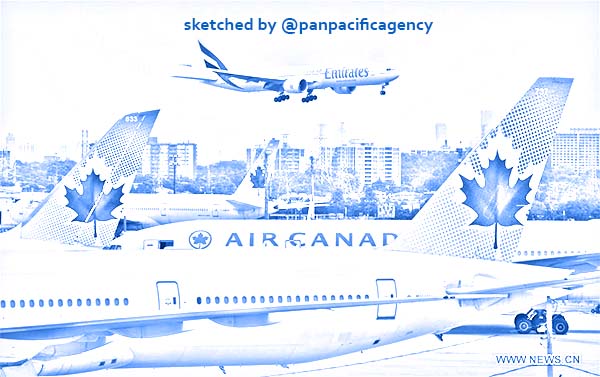Airline industry needs billions more in bailouts to survive: International Air Transport Association

A plane prepares to land at Pearson International Airport in Toronto, Canada, on Aug. 3, 2020. Travel restrictions in Canada will be extended until Aug. 31 to reduce the spread of COVID-19. (Photo by Zou Zheng/Xinhua). Sketched by the Pan Pacific Agency.
HONG KONG, Oct 7, 2020, SCMP. Global airlines need a fresh cash injection worth billions to stave off the increasing bankruptcy threat from Covid-19, the International Air Transport Association (IATA) has warned, with the industry set to burn a further US$77 billion, or US$300,000 a minute, in the second half of 2020, South China Morning Post reported.
Some carriers would find it impossible to survive without an increase to the US$180 billion of mostly government support already handed to the industry, a sum covering only 8½ months of sector losses that were likely to continue into 2022, the trade group said on Tuesday.
“We’re looking [at] airlines getting into trouble or failing without either further government support or airlines being able to access capital markets for more cash,” warned IATA chief economist Brian Pearce.
The already ruinous haemorrhaging of cash is having severe consequences on several affiliates in the AirAsia Group, one of the region’s pioneering low-cost airlines, which shut down its Japan operations on Monday, while its Indian arm is no longer being financially supported.
AirAsia X, its low-cost, long-haul unit, said on Tuesday it was seeking a do-or-die US$15 billion debt restructuring.
Cathay Pacific warned last week its monthly cash burn, which has hit HK$2 billion, would continue to be significant until passenger traffic rebounded to a much higher level.
Hong Kong’s flagship carrier has so far shrugged off questions about whether it needs more help. It has already secured HK$39 billion in support, of which HK$27.3 billion came from the Hong Kong government.
Remaining the outlier, China was “in better shape”, IATA said, given the near full recovery of the profit-generating domestic market, further stimulated by the “golden week” holidays.
At least 30 to 40 airlines across the world had so far either failed or entered bankruptcy restructuring, but as government cash support whittled away, more airlines faced financial trouble over the next six to 12 months, according to the industry body.
IATA pointed out that airline revenue plummeted by four-fifths in the second quarter of this year, despite the boost from air cargo, while expenses had only halved year-on-year.
Labour costs fell the least, and “this is why airlines are burning through cash and making significant losses”, Pearce explained.
Wage subsidy schemes – a key plank of the bailout money for offsetting labour costs – were starting to expire with extensions now required, the industry body said.
“The crisis is growing longer and deeper than anyone could imagine,” said IATA director general and CEO Alexandre de Juniac.
With wage support ending, he said: “It is time to ask governments to take extra measures to replace and extend them into the longer term. The potential for failure and job losses in the coming months is enormous.”
The only glimmer of hope from the IATA figures was that the US$51 billion the airlines burned through in the second quarter, was lower than the US$61 billion initially projected.
But by the end of the year the cash wipeout over the nine months from March was expected to climb to US$128 billion.
“All airlines have got their backs against the wall. How do you survive the crisis if you do not have someone to back you up?” said Subhas Menon, director general of the Association of Asia-Pacific Airlines (AAPA).
Menon added: “This all depends on the wherewithal of the shareholders and the government. How long is a piece of string? When the spool runs out, what happens to the entity? So, those who do not have support to keep going are facing an existential issue. What you see with AirAsia is a question of that.”
The AAPA chief said the swift but considered reopening of borders in the Asia-Pacific region, where more are closed than in any other part of the world, was vital.
Singapore, fearing the wider economic fallout, signalled on Monday its intention to get travel bubbles up and running with few restrictions to economies such as Hong Kong, where the virus was less of a threat.
Meanwhile, in the first major assessment of travel prospects in the longer term, US planemaker Boeing on Tuesday blamed the ongoing pandemic for demand for jets falling 11 per cent this decade, to 18,350 aircraft, compared with 2019 estimates. The downgrade shaves US$200 billion off the revised US$2.9 trillion-worth of plane sales.